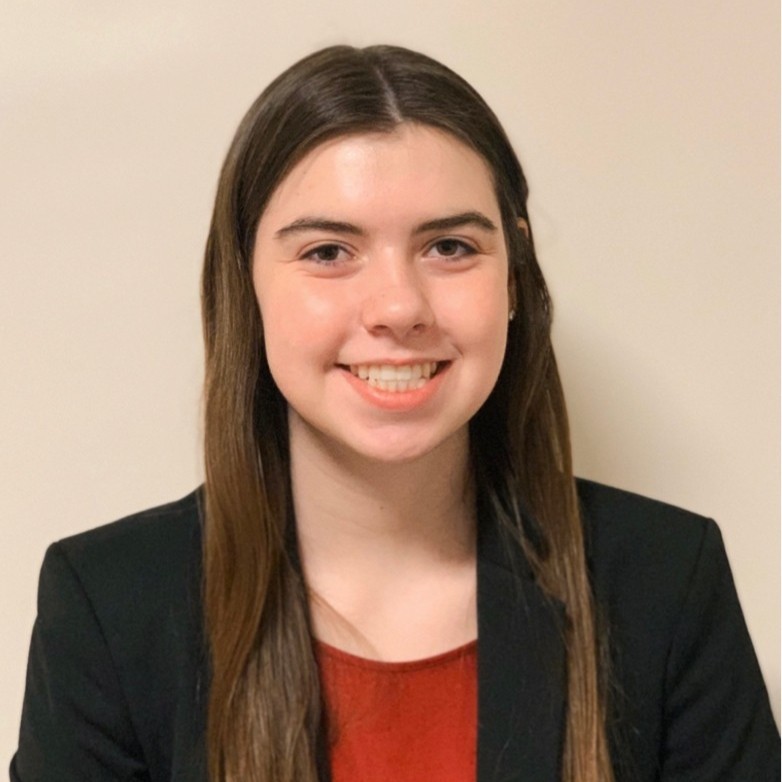Once you are done with college, you must think of the next step; employment. Getting a job requires you to create a resume that highlights your qualifications. A college student’s resume is a document showing a college student’s skills and qualifications. Unlike the ordinary resume, it relies heavily on the applicant’s college coursework, awards, and activities.
Being a college student, you are not expected to have work experience. However, your resume should show how valuable and proactive you are. The resume should include your college achievements, awards, volunteer activities, and other relevant extracurricular activities. Your coursework should form the majority of the resume because it highlights the relevant subject you have studied and gives you a basis for the job you seek.
A good resume highlights your best qualities and value to the recruiter. It helps you stand out from the other applicants and increases your chances of getting the job. As such, you should know how to write an effective resume.
This article will guide you on:
- The best formats for a college student resume
- What to include in a college student’s resume
- How to format your resume for the best results
- Some do’s and don’ts for writing the resume.
Best Resume Format and Guidelines for a College Student
There are three main resume formats used when creating resumes; chronological, functional, and combination resumes. The functional resume is the most preferred for college students because it emphasizes the skills of the student rather than work experience. This resume format allows the recruiter to understand your value through the skills you will highlight, enabling you to shift the employer’s focus from your lack of work experience.
When preparing your resume, there are a few best formatting practices you should employ:
- Keep the resume to one page. Typical resumes should not be longer than one page unless the job description demands it.
- Proofread and review your resume before sending it to avoid grammar mistakes that may make you appear careless.
- List your experiences in reverse-chronological order beginning with the most recent, and work backward.
- List your skills and roles in your work experience section in bullet points.
- List a maximum of eight skills on your resume.
- Use simple and official fonts like; Arial and Times New Roman.
Format of a College Student Resume
An effective resume should clearly highlight your skills and merits while maintaining a professional tone. You should also include key information that will help the recruiter understand your value.
The following format can help you outline your skills well:
Resume header
Your resume header should include contact information; name, title, phone number, email address, and physical address. You may also include your social media and website links, like LinkedIn URLs, if they are relevant to the position. Including social media links allow the recruiter to see samples of your work, especially for social media-intensive jobs. Further, the recruiter assesses your experience through the professional connections you have established on sites like LinkedIn.
Information like your date of birth is irrelevant when applying for a job unless the job description requires you to verify your age. Other information that should not be included in your header includes an unprofessional email address and photographs. Your header should be creative to attract the attention of the recruiter. Review your header and ensure you have given current contacts.
EXAMPLE
Mary Jane – Student
Tel: 555 678373, Email: maryjane@gmail.com
Objective or summary
The objective or summary is a brief introduction stating your experiences and achievements, typically 2-4 lines long. It is meant to give the recruiter a hint of the resume by highlighting your best qualities and what sets you apart from the other applicants. A resume summary is best for applicants with work experience because it emphasizes their qualifications. A resume objective is best for applicants without work experience because it emphasizes their skills and personal goals.
pro tip
Ensure you engage the recruiter by using formal but positive language and action verbs when writing your resume. Include personal attributes that make you an excellent fit for the job and describe how your best skills have helped you achieve objectives at your previous jobs.
EXAMPLE
Software engineering sophomore with extensive experience in software development, coding and skills in SQL and database concepts. I am self-motivated and a team player with the ability to work across different departments.
Education
When writing your education section, begin with your most recent educational qualification. The education section should show the recruiter that you have all the formal requirements for the position.
State each qualification in the following format:
- Institution-university/college
- Location of the institution, including the city or state
- Program (master’s, bachelor’s, or diploma)
- Years attended, including the start and end years.
- GPA if you had a GPA of 3.5 or more
- Awards, merits, or honors
- Mention if you were on the dean’s list.
EXAMPLE
B.A in Finance and Accounting
University of St. Lauderdale
September 2017- December 2020
Second Class Honours (Upper division)
tip
Start by listing your latest educational qualification, then work backward. If you have a degree, do not mention your high school degree unless you are explicitly required to include it. If you are yet to finish your degree, you can mention your latest year of study.
Work experience
It would be best if you titled this section ‘Relevant experience’ instead of ‘Work experience’ because it allows you to provide more than your job history.
Your work experience should follow the format below:
- The job title
- The company name and location
- Duration of employment, including start and end dates
- Roles, duties, or responsibilities
In this section, you may include any internships, volunteer work, interests and hobbies, clubs, and extracurricular activities. In each of these activities, be sure to mention the capacity of your participation, i.e., volunteer, resource, etc. Mention the roles you played, and include measurable results when stating your roles to give the recruiter an idea of your experiences and highlight your experience level. It is also recommended that you state any leadership position you held, as this shows positive personal attributes such as teamwork and management skills.
EXAMPLE
Relevant Experience
English Tutor, Hersch College, Illinois, IL
May 2015 – May 2016
Duties
- Oversaw student examinations for two semesters.
- Assigned and collected assignments for two classes of 20 students for a semester.
- Assisted students in correcting their papers and increased the English pass rate by 9%.
key tips
The work experience section needs to be engaging. Begin each role with an action verb, for example, assigned, improved, developed. The verbs reinforce your experience with the recruiter. Provide brief but detailed descriptions of your role and quantify the results of your work where you can.
Skills
Your skills section should include your technical, hard, and soft skills. Technical skills are skills relevant to the job position. If you are applying for an IT job, technical skills could include writing code in JavaScript and Python. Hard skills are typical every day, transferrable skills, like writing and research. Soft skills are perceived as strengths like; self-motivation, adaptability, working under minimum supervision, etc. You can list each of the categories of skill in its sub-section.
You should first create a general list to ensure you capture all your skills. These should include technical, hard, and soft skills. Then identify the skills relevant to the field and position you are applying for. For entry-level jobs, you should include transferable skills. If it’s a job specific to a particular field, for example, technology, make sure the hard skills are relevant to the job.
After identifying industry-relevant skills, narrow the list down to the most relevant skills by assessing the skills required in the job description. Aligning your skills to the job description boosts your resume and ensures it will pass should it be taken through an ATS.
Your skills section may appear as follows:
Skills
Technical skills
- Proficiency in Microsoft Excel
- Excellent research skills
- Data analysis
- Editing
- Bookkeeping
Soft skills
- Public speaking
- Excellent communication skills
- Problem-solving and conflict resolution
- Customer service
Additional sections
The additional sections may include other activities that make you stand out. They may highlight your attributes, especially when a recruiter has to choose between you and another applicant. Make sure these activities have a bearing on the position or show your transferable skills. They include languages, hobbies, volunteer opportunities, and awards.
When listing languages, you should state the degree of expertise, whether it is your native language, whether you can speak and write only, or are fluent. If you have published works, you should include them by stating their titles and where they are published.
EXAMPLE
Additional Sections
Volunteer, Waputi Environmental Champions.
- Planted and cared for 100 trees over three months
- Participated in the clean-up of Waputi river
- Held environmental sensitization programs
Choosing the Correct Keywords for a College Student’s Resume
Your resume should be tailored to the job description. Understanding what the recruiter needs from you is important to ensure your resume is not filtered out in case it passes through an ATS.
There are two methods of choosing the correct keywords:
Analyzing the job description
The job description contains specific terminologies on the skills and qualifications required of an applicant. List these terminologies and keywords and ensure you include them in your application.
Research on the industry
You can look through the company website to understand its mission, vision, and goals. Then tailor your resume to reflect and align your qualifications to the company’s goals. Your research should also let you know the language used by the company, and you can tailor the resume to align your language with theirs. For example, to provide a platform for the development of eco-centered technology. Such language tells you of the company’s values and objectives. You can therefore align your skills to fit their needs.
Download Free Templates
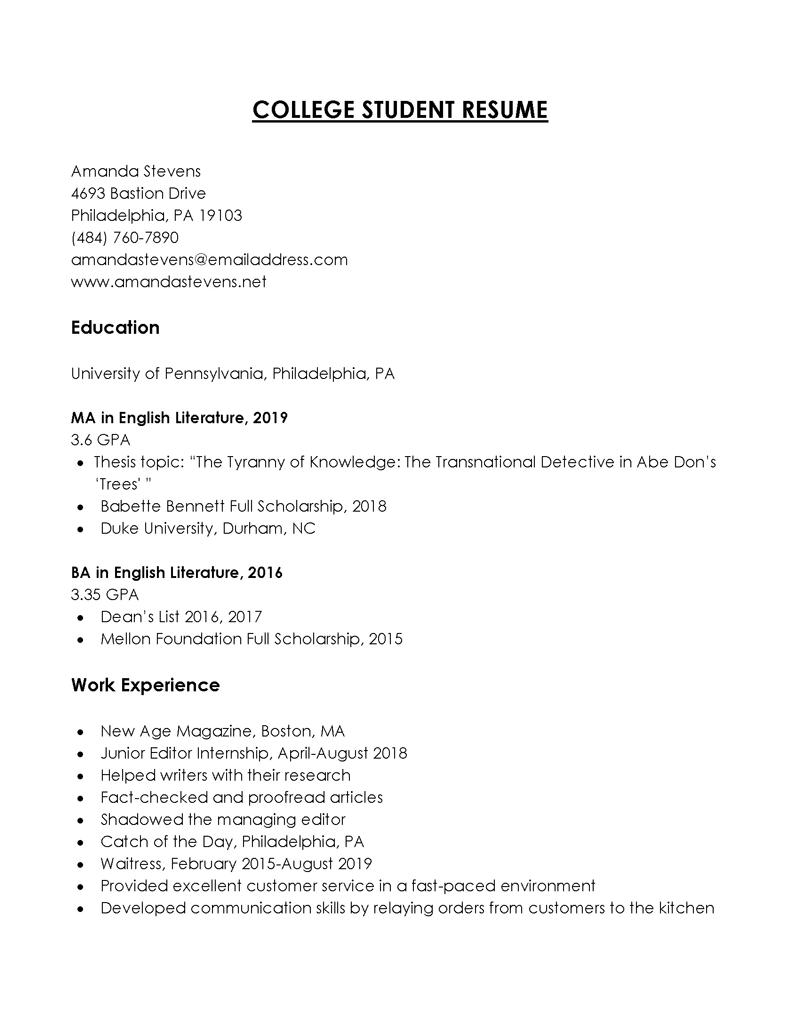
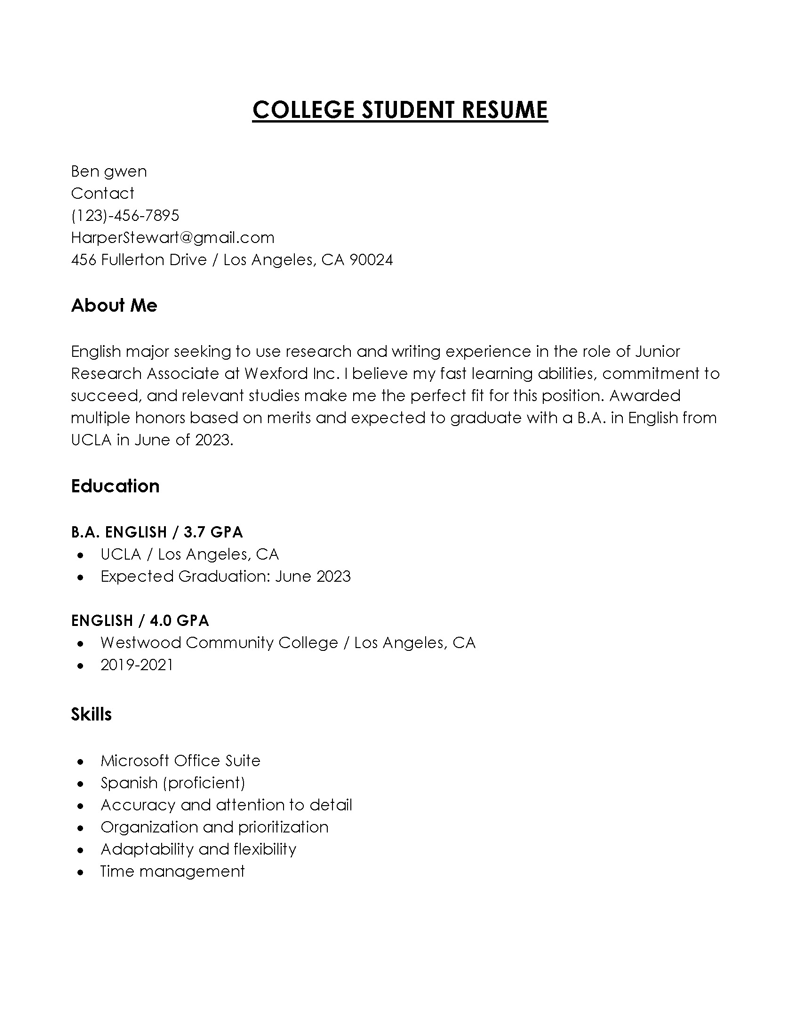
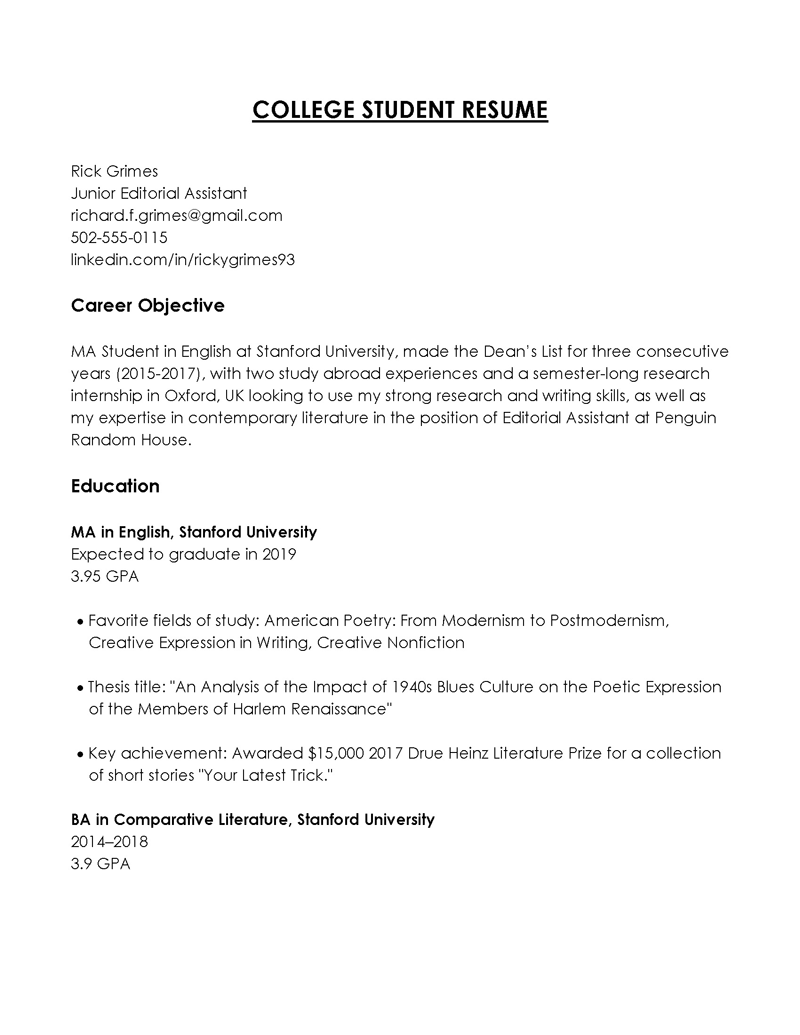
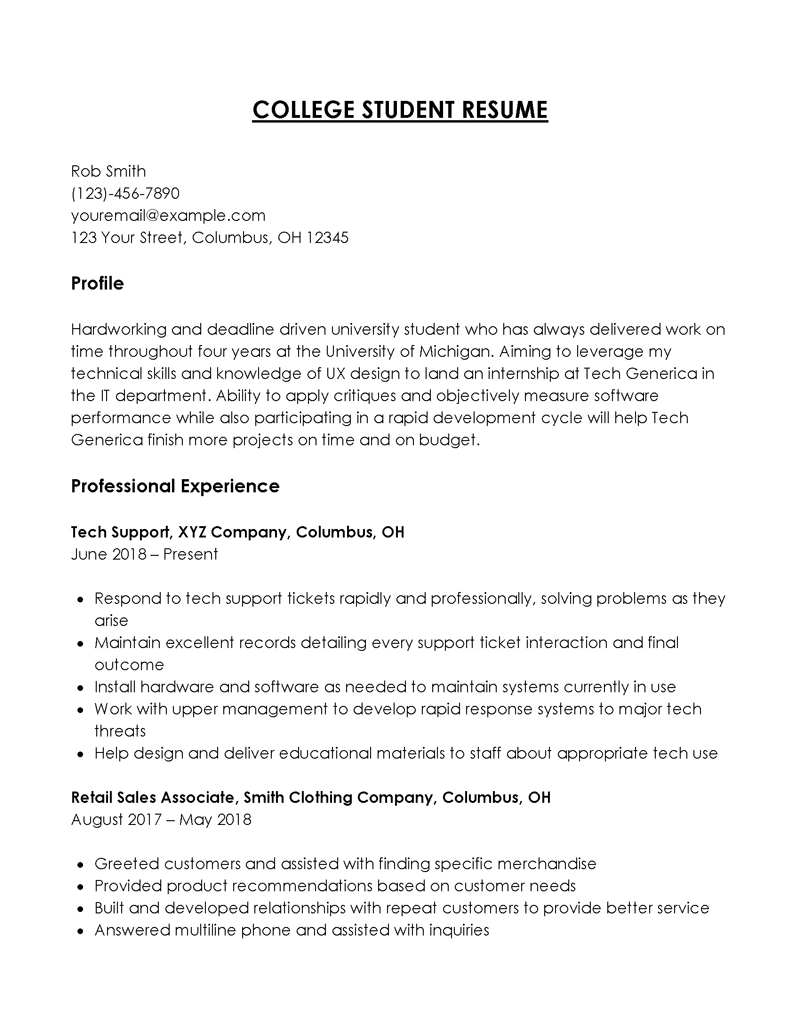
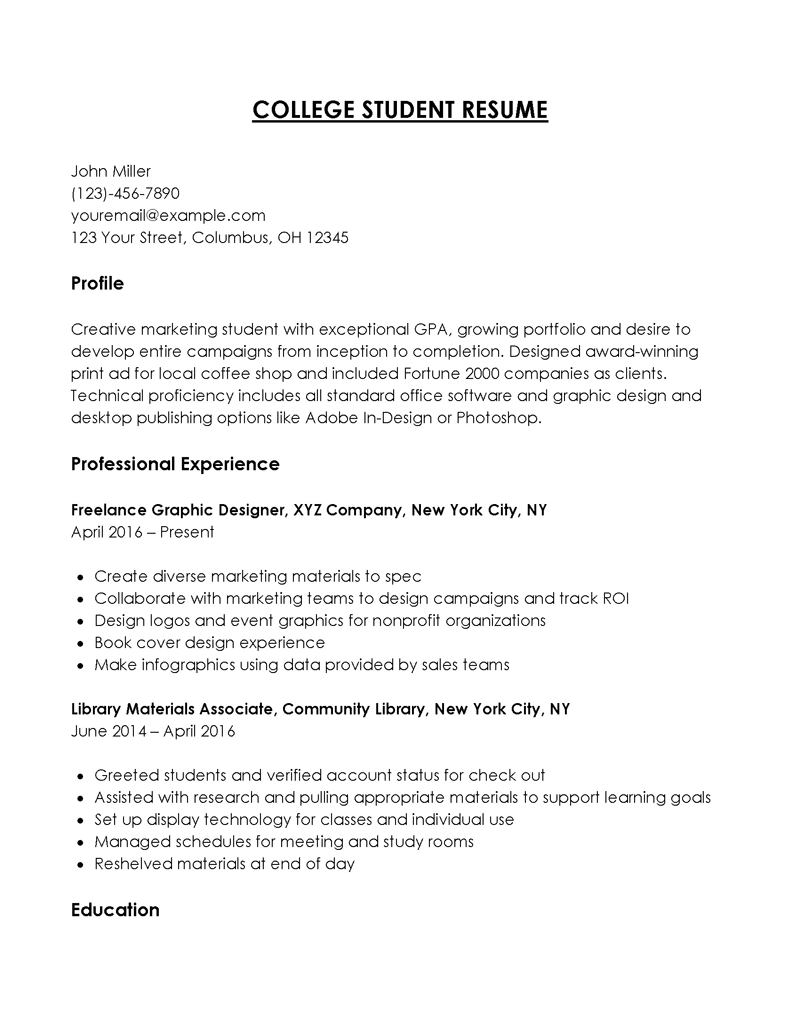
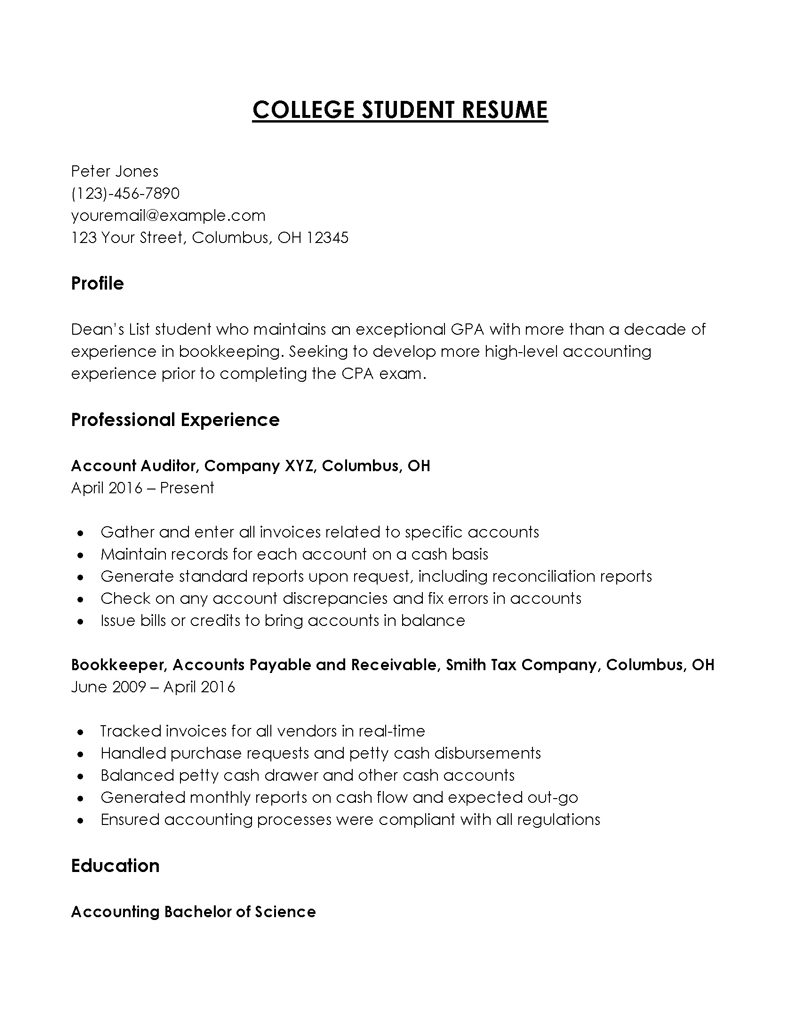
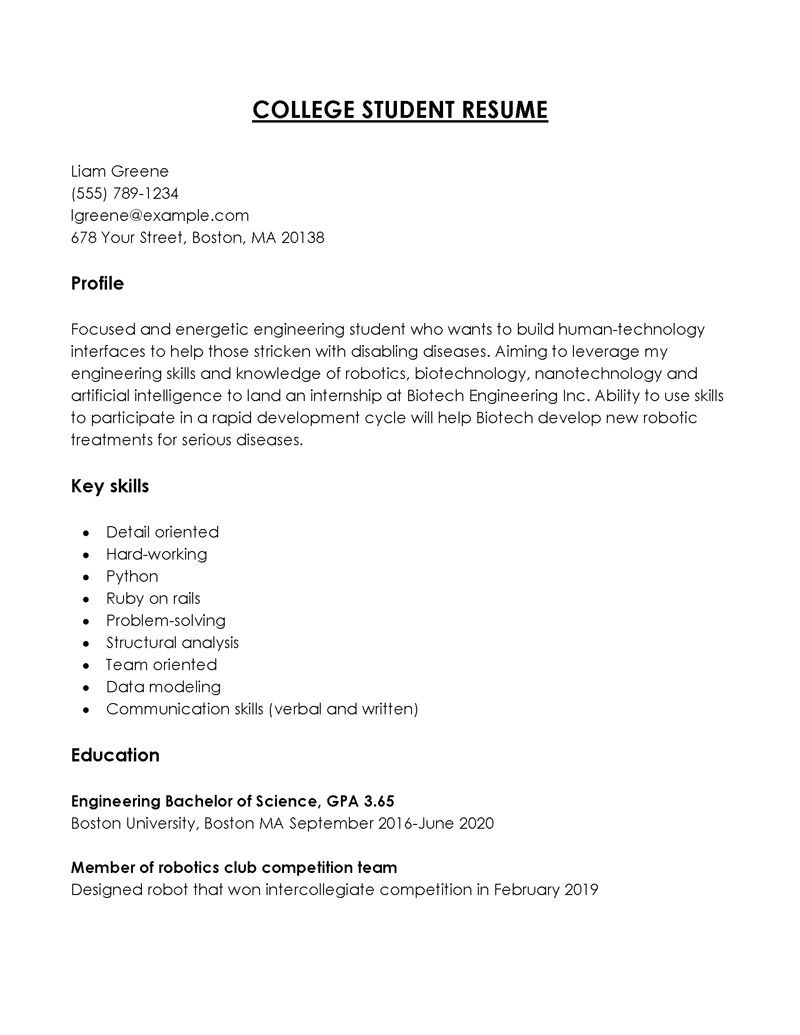
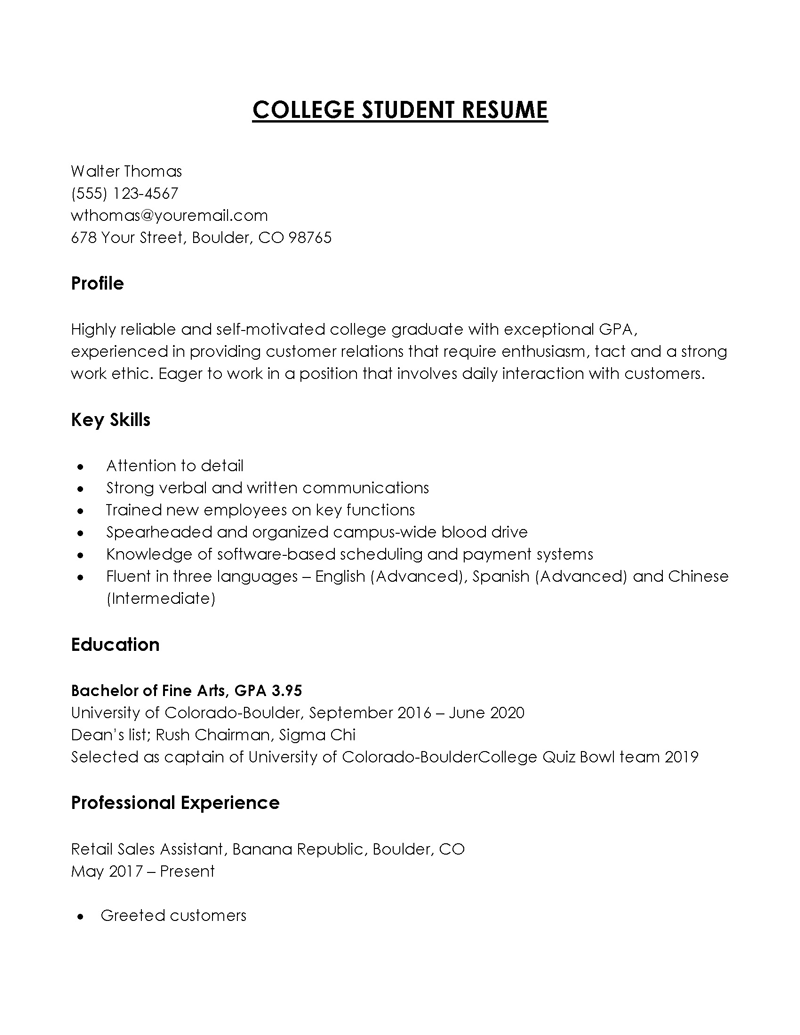
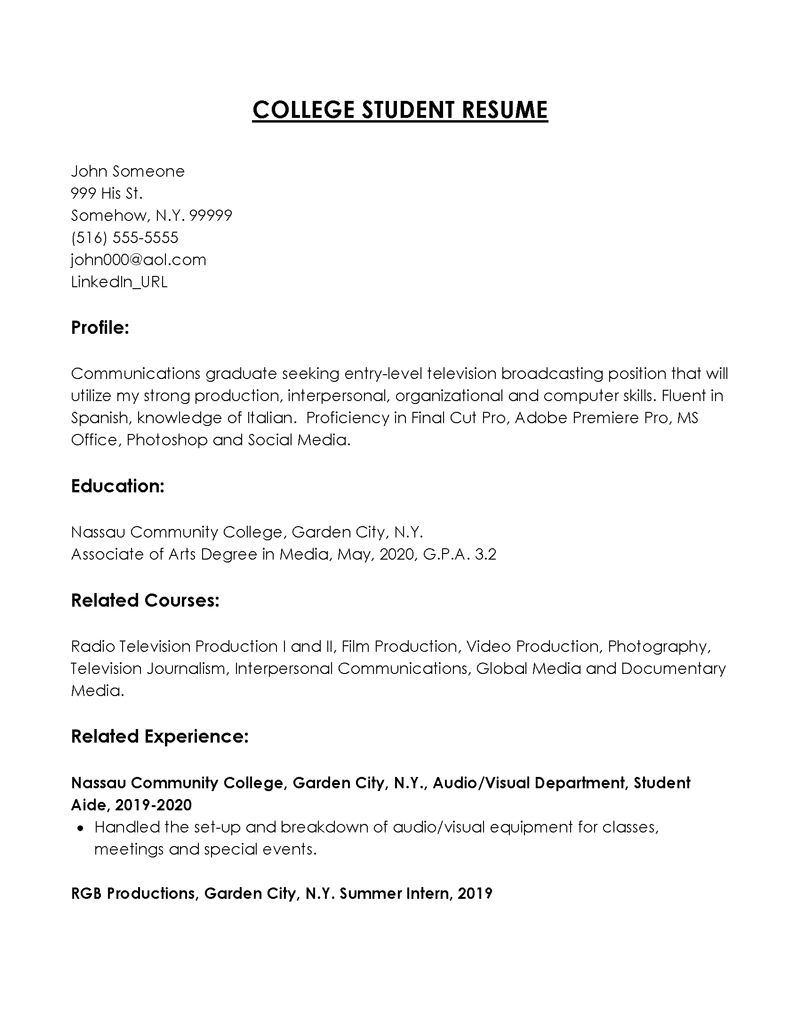
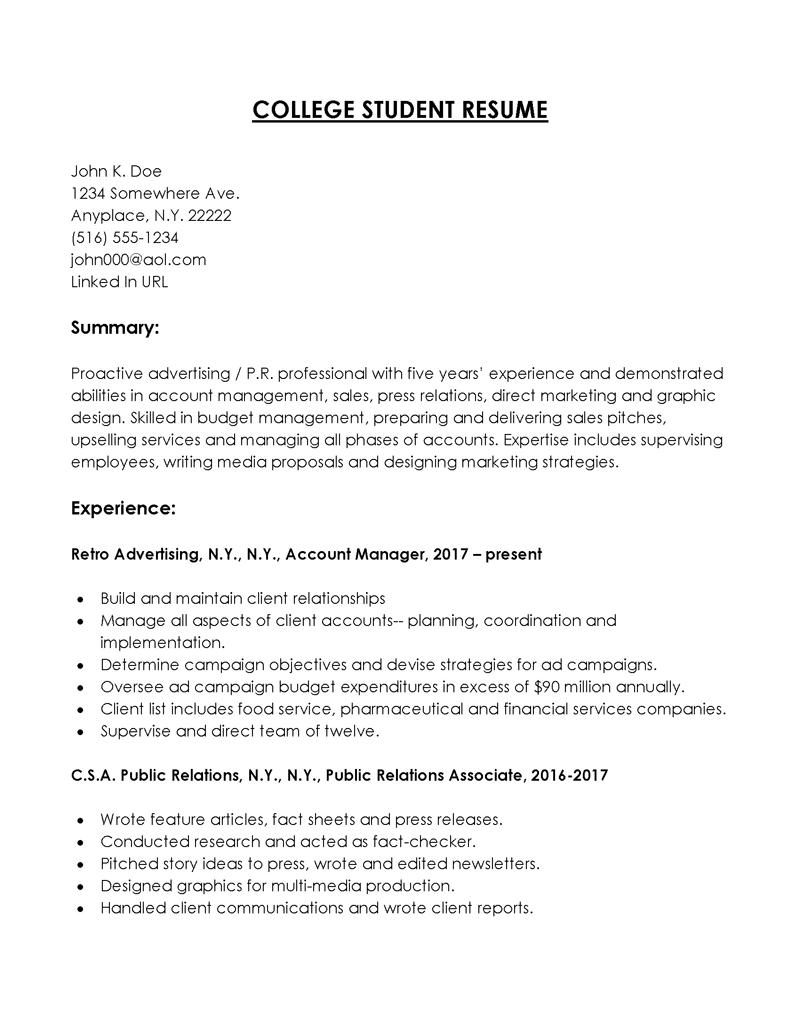
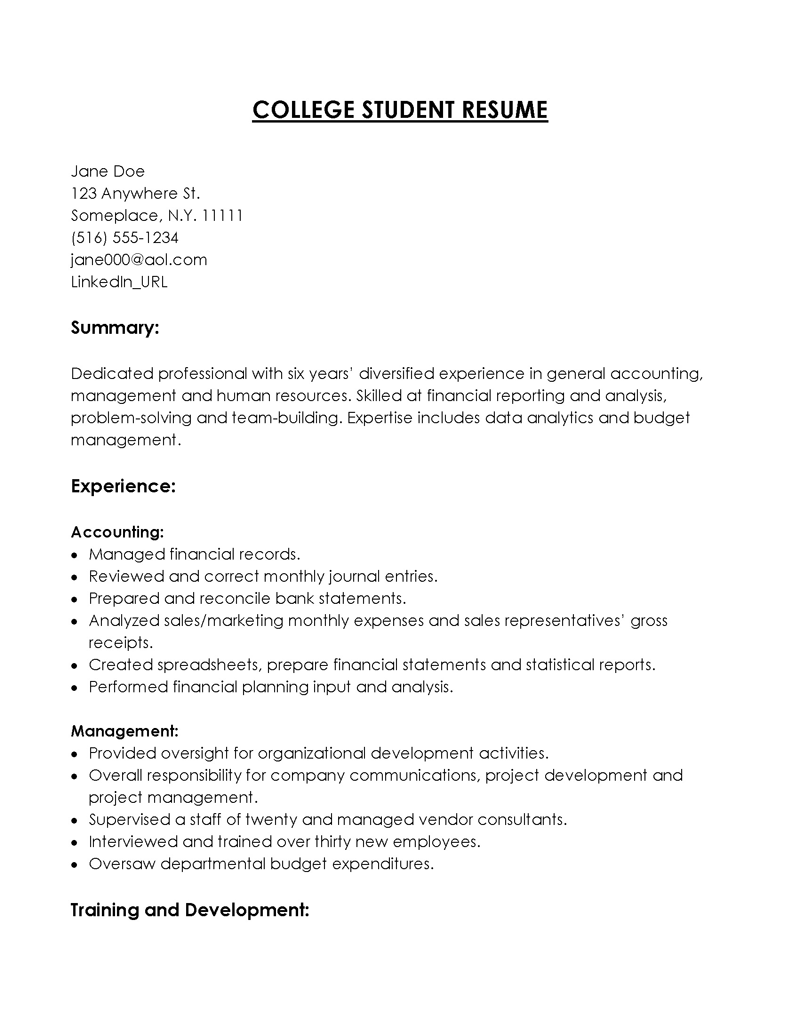
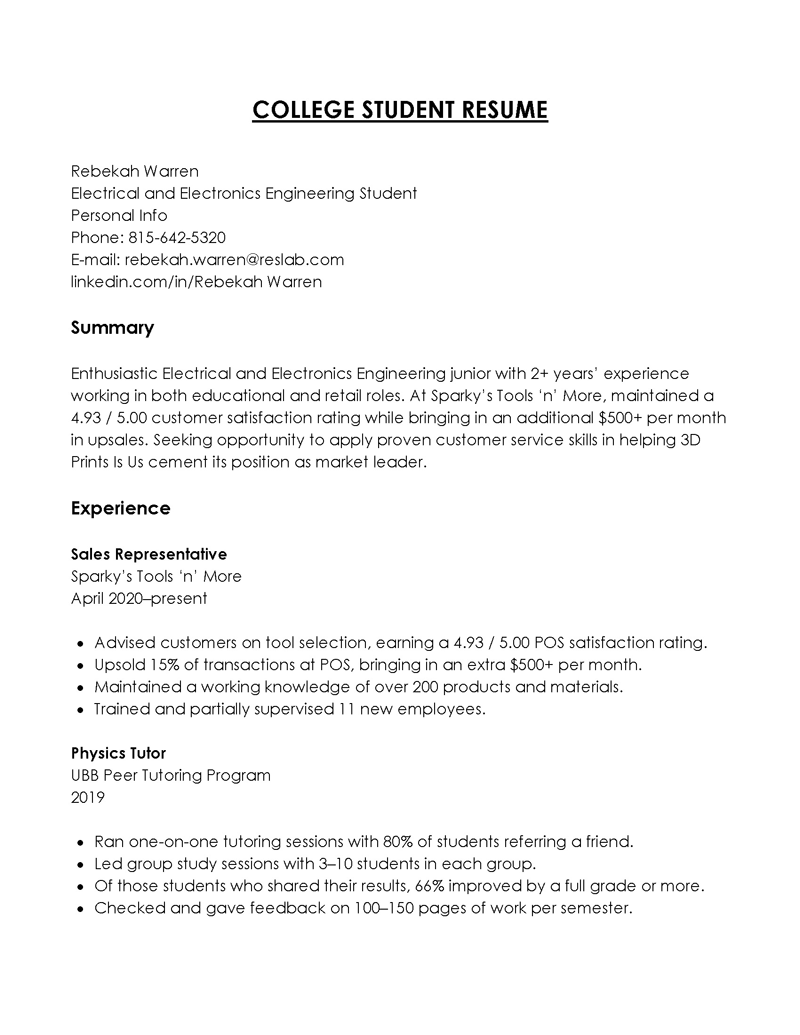
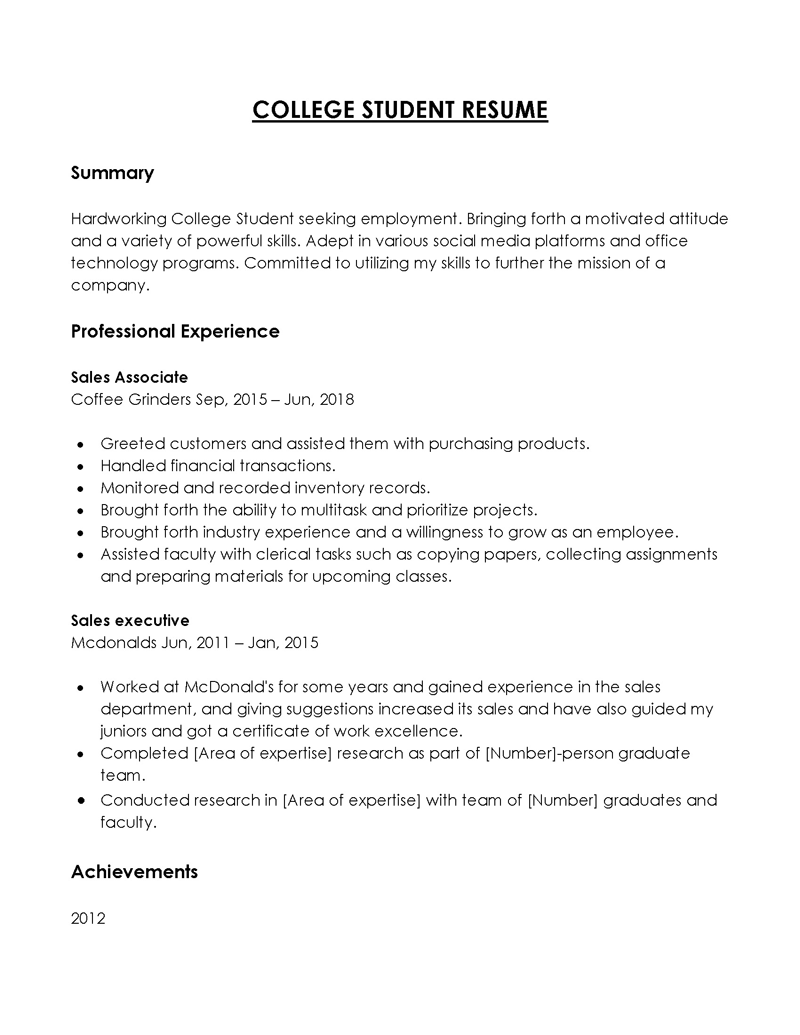
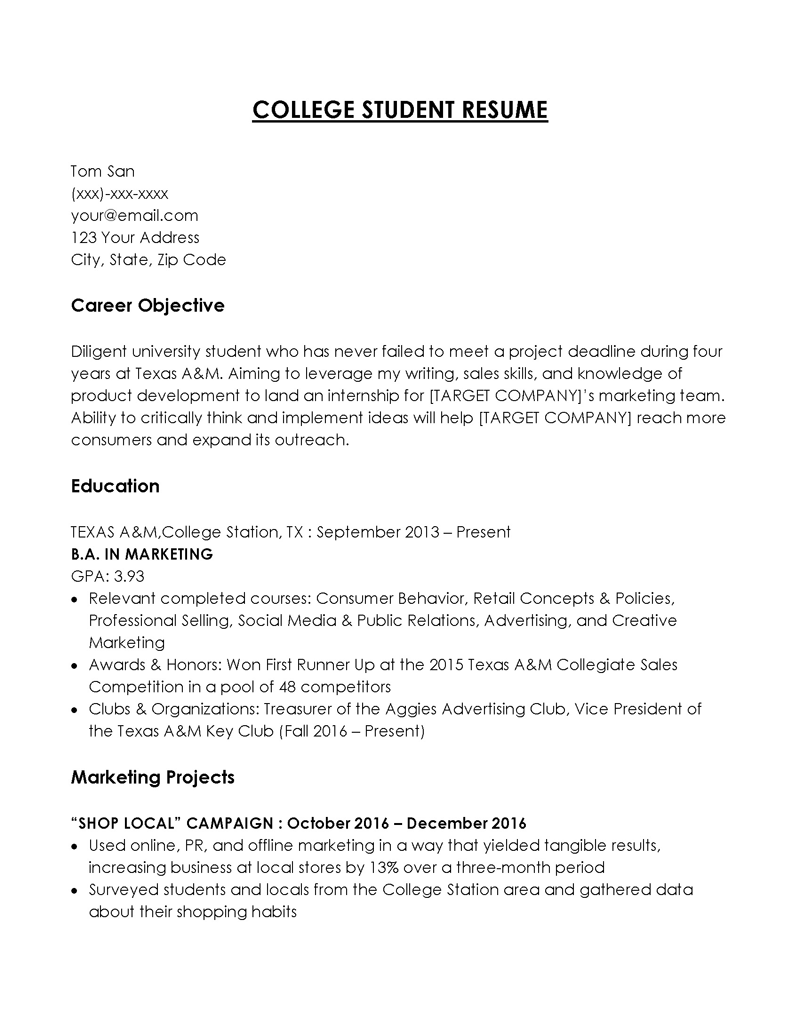
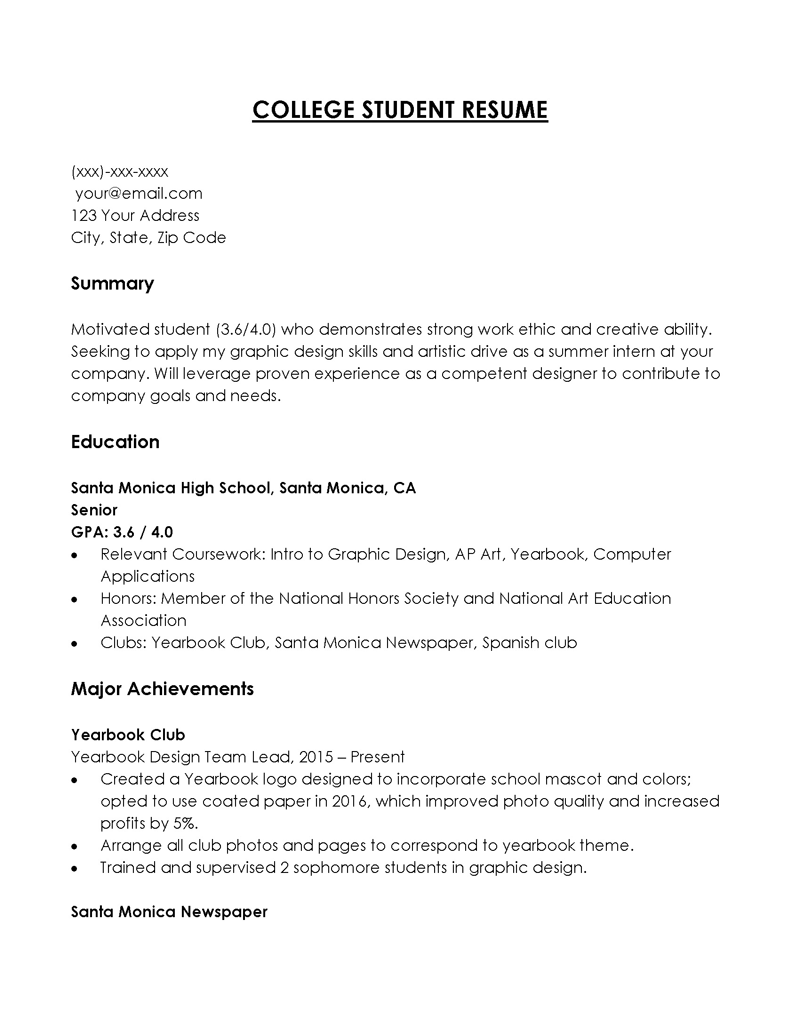
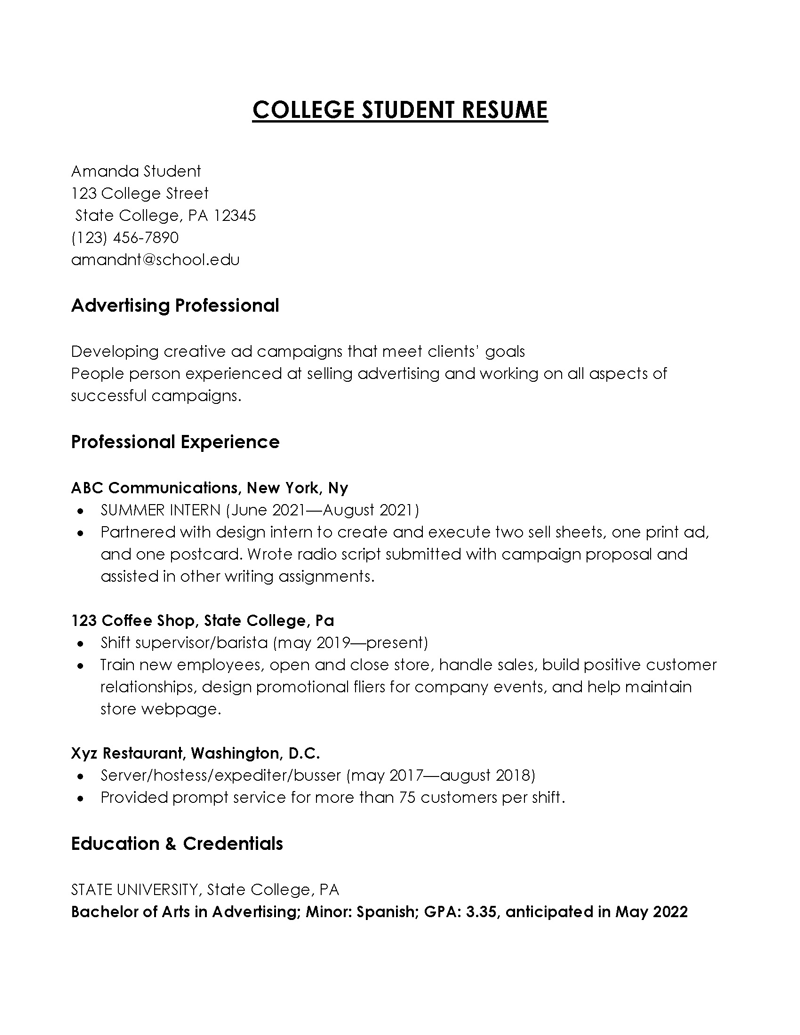
Dos and Don’ts
Through time some practices have developed in the preparation of resumes. Some things are inappropriate, while others are shown to improve your chances of getting a response to your resume.
They include:
Do’s
The following is a list of best practices that you should consider when writing your resume for a college student:
- Organize your resume sections according to priority. For example, where you want to include experience, put your experience section before your skill section.
- Use a simple and clear format, following the rules of formatting.
- Be brief and to the point, do not include irrelevant information.
- Use keywords in the job description.
- Proofread and review your resume for spelling and grammar mistakes.
- Use a layout that offsets the parts of your resume that might appear dense.
Don’ts
Things to avoid when drafting a college student’s resume include the following:
- Don’t include experiences that will show you in a bad light.
- Avoid Including photographs or other types of graphics on your resume not unless you are instructed to do so.
- Don’t lie to make yourself look qualified. If it is discovered, you may be terminated.
- Refrain from creating unnecessary sections. For example, do not use the term work experience if you have none.
- Don’t write long paragraphs or texts; use varied sentence structure and shorter paragraphs.
- Avoid writing a resume longer than one page.
Final Thoughts
As a college student, it is advisable to start looking for jobs as early as possible. If you have already settled on a career, look for entry-level or part-time jobs. Create an effective resume by including your education qualifications, awards, and other achievements on top of your work experience. Be sure to show that you are proactive so the recruiter can assess your value. When preparing your resume, use keywords to ensure the ATS does not filter it out. Tailor your resume to the role you seek and research each role so that you stay updated.
